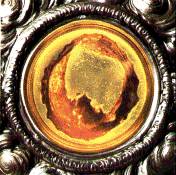Thank you! Most interesting article, replete with errors. For example, the author writes:
idea of a physical presence was vaguely held by some, such as Ambrose
The earliest text concerning the Real Presence is found in Paul's first epistle to the Corinthians, written about 57AD, or 27 years after Christ's death. Paul's Eucharistic teaching in 1 Corinthians leaves us in no doubt. "For this is what I received from the Lord and in turn passed on to you: That on the same night as he was betrayed, the Lord Jesus took some bread, and thanked God for it, and broke it, and he said, 'This is my body which is for you; do this as a memorial of me.' In the same way he took the cup after supper and said, 'This cup is a new covenant in my blood. Whenever you drink it, do this as a memorial of me.' Until the Lord comes, therefore, every time you eat this bread and drink this cup, you are proclaiming his death. And so anyone who eats the bread or drinks the cup of the Lord unworthily will be behaving unworthily toward the body and blood of the Lord. Everyone is to recollect himself before eating this bread and drinking this cup, because a person who eats and drinks without recognizing the body is eating and drinking his own condemnation" (1 Cor. 11:23-29).
In the previous chapter the apostle wrote, "The blessing-cup that we bless is a communion with the blood of Christ, and the bread that we break is communion with the body of Christ" (1 Cor. 11:16). His words are clear. The only possible meaning is that the bread and wine at the consecration become Christ's actual body and blood. Evidently Paul believed that the words Christ had said at the Last Supper, "This is my Body," meant that really and physically the bread is his body. In fact Christ was not merely saying that the bread was his body; he was decreeing that it should be so and that it is so.
Let's put this to the test. Is the consecrated host truly the Body of our Lord Jesus Christ. Over the centuries, there have always been doubters, including priests. The first and greatest Eucharistic Miracle of the Catholic Church took place in Lanciano Italy in the 8th century. During Holy Mass, after the two-fold consecration, the host was changed into live Flesh and the wine was changed into live Blood, which coagulated into five globules, irregular and differing in shape and size. It physically changed in appearance.

Various ecclesiastical investigation ("Recognitions") were conducted since 1574.
In 1970-'71 and taken up again partly in 1981 there took place a scientific investigation by the most illustrious scientist Prof. Odoardo Linoli, eminent Professor in Anatomy and Pathological Histology and in Chemistry and Clinical Microscopy. He was assisted by Prof. Ruggero Bertelli of the University of Siena.
The analyses were conducted with absolute and unquestionable scientific precision and they were documented with a series of microscopic photographs.
These analyses sustained the following conclusions:
- The Flesh is real Flesh. The Blood is real Blood.
- The Flesh and the Blood belong to the human species.
- The Flesh consists of the muscular tissue of the heart.
- In the Flesh we see present in section: the myocardium, the endocardium, the vagus nerve and also the left ventricle of the heart for the large thickness of the myocardium.
- The Flesh is a "HEART" complete in its essential structure.
- The Flesh and the Blood have the same blood-type: AB (Blood-type identical to that which Prof. Baima Bollone uncovered in the Holy Shroud of Turin).
- In the Blood there were found proteins in the same normal proportions (percentage-wise) as are found in the sero-proteic make-up of the fresh normal blood.
- In the Blood there were also found these minerals: chlorides, phosphorus, magnesium, potassium, sodium and calcium.
- The preservation of the Flesh and of the Blood, which were left in their natural state for twelve centuries and exposed to the action of atmospheric and biological agents, remains an extraordinary phenomenon.
 |
Fig. 1 - Eosine x 200. Overall histological aspect of a Flesh sample with fibers collected in bundles with longitudinal orientation as it occurs in the outer surface layers of the heart. |
| Fig. 2 - Miracle Heart in Lanciano. Mallory x 250. An artery and, very close, a branch of the vagal nerve. |
|
 |
Fig. 3 - Miracle Heart in Lanciano. Mallory x 400. Evidence of the "Rough" aspect of the endocardium; the syncytoid structure of the myocardial tissue |
 |
Fig. 4 - Elution-absorption test x 80. Above: Hemagglutination test on blood sample in Lanciano: on the left, anti A serum used; on the right, anti-B serum. Below: hemoagglutination test on a Flesh sample in Lanciano: left, with anti-A serum, right,with anti-B serum. It appears thus that the Flesh and the Blood in Lanciano belong to AB blood group. |
| Fig. 5 - Electro-phoretic pattern of Blood proteins (Cromoscan photometer). The profile of serum fractions is normal and superimposable to that of a fresh serum sample. |
In conclusion, it may be said that Science, when called upon to testify, has given a certain and thorough response as regards the authenticity of the Eucharistic Miracle of Lanciano.
There will always be skeptics, like St. Thomas, who will not accept or believe until they have have seen (John 20:24-29).